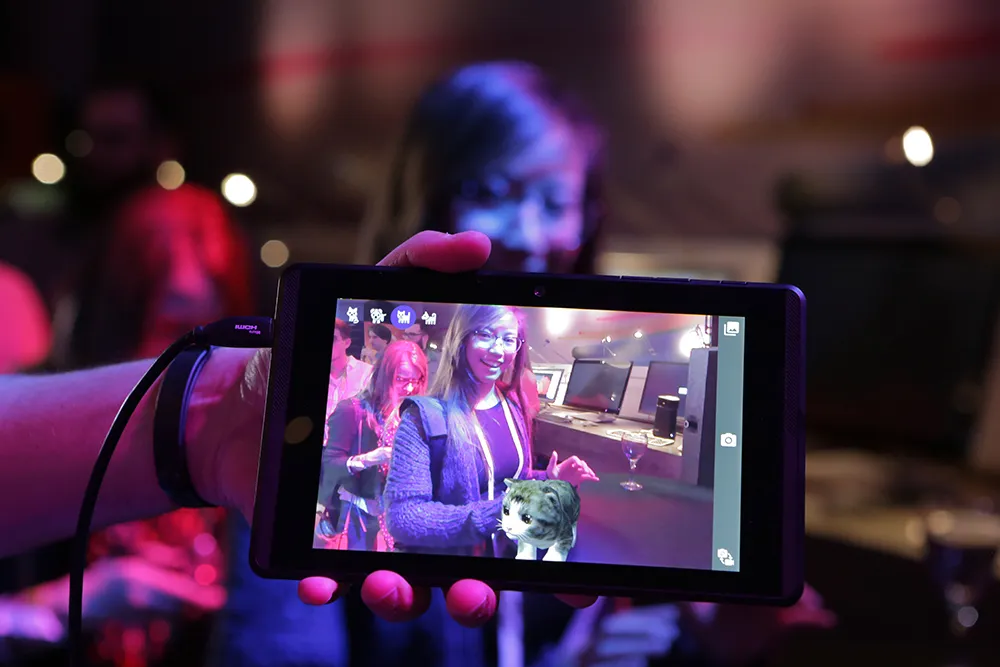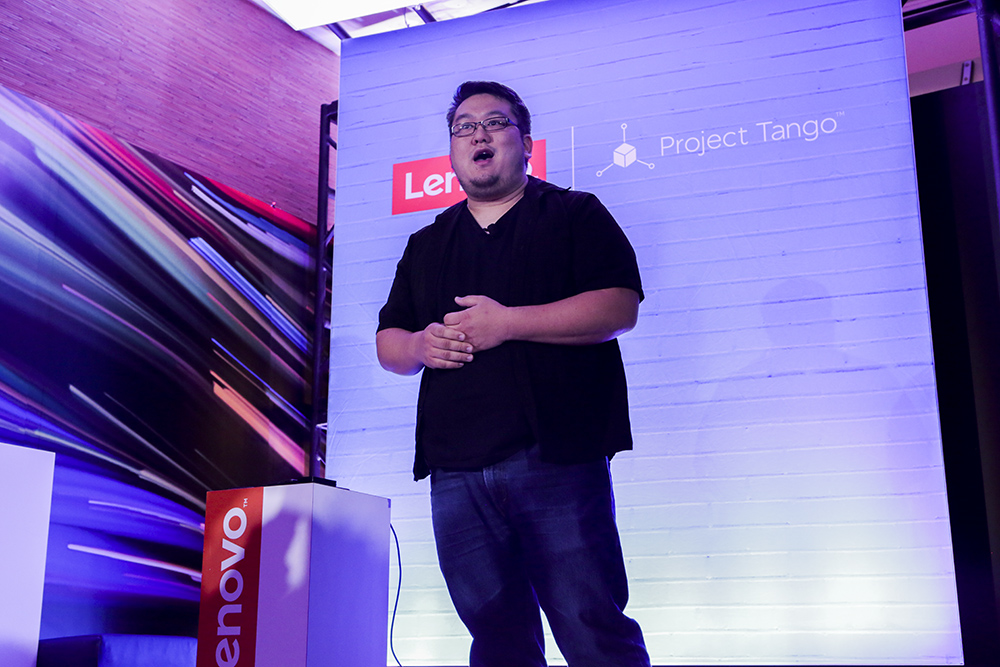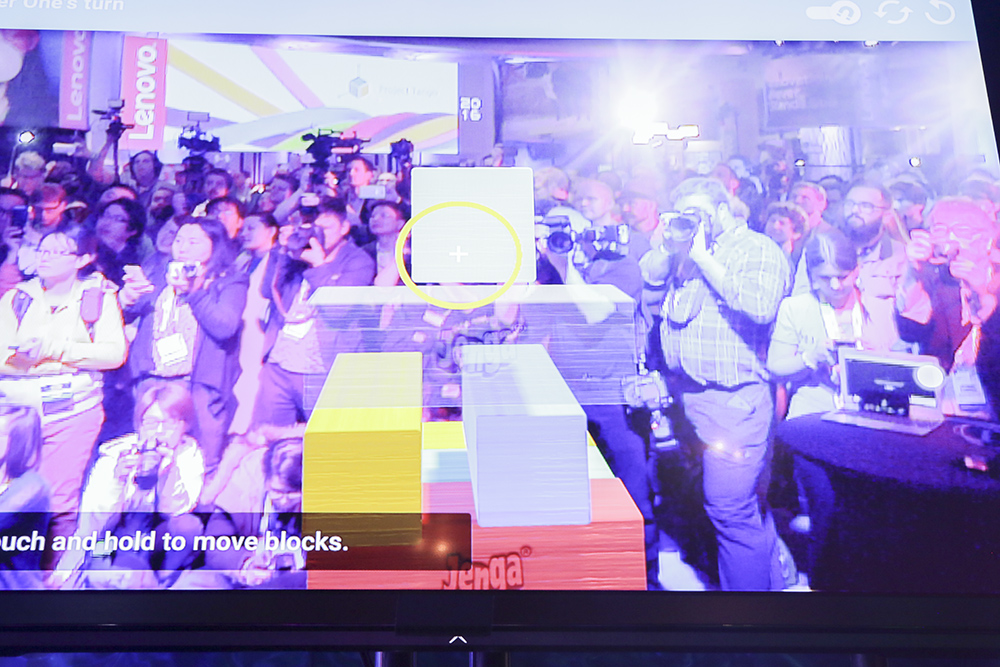Anticipation grows as the press line wraps around the hall at the Venetian. Zac Lambert, Lenovo’s Communication Manager, approaches various members of the media to see if anyone can figure out what Lenovo plans to announce at their CES presentation. No one has a clue, but the line starts moving. The words “Let’s Tango” are the first thing we see as we enter the room.
Project Tango’s Johnny Lee takes the stage holding a Google Project Tango Developer Tablet. Before he starts his demos, he introduces the idea of human scale – the understanding of space and motion as it is for humans. Currently, mobile devices don’t have any perception of human scale, so what happens when we start giving them the same perception of space that we, as humans, have? Lee quickly addresses this point with his first demo … using the Project Tango Developer Tablet, he measures the height of the room, the size of the carpet on stage, and he places a virtual couch that is to scale on stage. The crowd goes wild as they watch the virtual room begin to form on screens around the room.
The second demo he shows is through an application on the tablet called Construction. Lee holds the tablet facing the side of the stage and starts to move around it, constructing a 3D model of the space by just facing it. Construction is an important application to many of those developing in the AR/VR space because it allows the user to build full 360 3D models of the surround space in real time through combining tracking and depth sensing data. It can also switch from first person POV to third then birds eye view. Best part? The 3D model of the space can then be imported into tools like Unity or Unreal Engine.
The third demo is by far the cutest. Let’s talk about virtual pets. Lee holding the tablet, places a virtual kitten on the floor of the stage. As Lee moves around the stage the kitten follows responding to the tables, the different textures on the floor (carpet vs wood), the edge of the stage, and the user him or herself. Then Lee switches over to a different app, designed by Schell Games, and invites an assistant on stage. They start playing Jenga with the Project Tango App. Not only is the accuracy of the user’s ability to remove blocks from the tower incredible, but the fact that the tablet is aware of real world physics was impressive. The ability to create games that utilize these things can create a whole new genre of games. AR has never looked so good. Is anyone else thinking about how cool it would be to have a Pokemon game on Project Tango? I know I am.
Arguably the best part of Project Tango is its focus on making the device aware of the information around us.
“[Project Tango] turns a phone or a tablet into a magical window,” Lee said.
But the software alone can’t make anything into a magical window … enter Jeff Meredith, VP at Lenovo.
For those unaware, Lenovo has been pushing the bounds of innovation for the past several years. Recently they launched the Droid Turbo2 phone, the first phone with a shatter proof screen. Several years ago they launched the Yoga Notebook, the world’s first 360 flipping laptop. And now they’ve partnered with Google’s Project Tango to announce the world’s first smartphone that utilizes Project Tango’s technology, RGB camera, depth sensor, and fish-eye lens.
Unlike the developer version of the tablet, the new smartphone is built to be something that can fit in your pocket. They revamped the layout and reoriented the camera stack to be in the top third of the back of the phone in vertical order. It’s a phone that was created with the sole purpose of being something that can be used everyday while building meaningful experiences in the 3D space.
Currently, the phone is still in consumer testing. It uses a Qualcomm Snapdragon processing chip (chip will be announced in the next few weeks) and will have a screen size less that 6.5 inches. Lenovo will be launching this phone in the summer of 2016 with a price point under $500 with the intention of changing the smartphone game and going mainstream. This is a fundamental shift because it can change how we interact with each other.
“We are 3D creatures, and devices need to share the same 3D perception that we have,” said Lee.
After some hands on with some of Google’s Project Tango apps it is clear that it is pushing AR. However, the ability to have depth sensing and tracking is huge for VR developers. For example, take Project Tango’s construction ability. VR app developers can use this and start creating experiences that have a guide like HTC Vive’s Chaperone system. Mobile VR experiences can start having positional tracking without having to create an accessory for it. If Lenovo’s device delivers on everything it says it can, this means people can start having truly immersive VR experiences regardless if they have a $1500 PC capable of running VR or not.
At the moment, the device is something that fits into your pocket and can do AR in your hands, but it’s not quite ready for VR wearable devices, such as headsets according to Anjana Srinivasan, Lenovo’s chief of staff for mobile business. But, both Project Tango and Lenovo understand the importance of their device and how it relates to VR industry, which currently relies on wearable devices. That’s why they’ve launched an incubator program called APP. This program is targeting developers in AR/VR and will be accepting proposals/applications until Feb. 15. If the AR/VR community can make a push for applications that will utilize this technology, we may just see a shift in Lenovo’s device just being used for “AR in your hands.” As technology continues to advance, we can see Google’s Project Tango and Lenovo’s smartphone changing the VR game as we know it.
Apply for the APP Incubator Program here: g.co/projecttango/appincubator.































